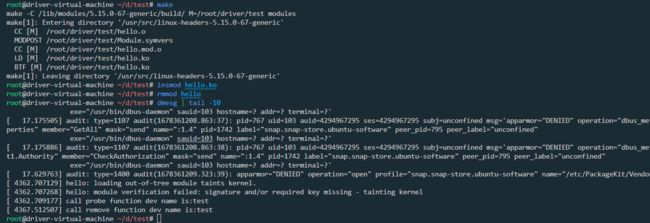linux UIO驱动实践
linux UIO驱动实践
- 环境搭建
- platform 设备驱动
- UIO驱动
环境搭建
Ubuntu20地址
虚拟机安装与配置见博客开头:驱动虚拟环境搭建记录
一直以为用镜像直接安装的Ubuntu没有内核源码,不能用来编译驱动,只能由源码编译内核后切换内核才能进行驱动的编译,没想到一安装完就可以编译了,错误的印象。
用hello world测试环境是否搭建成功
#include obj-m+=hello.o
all:
make -C /lib/modules/$(shell uname -r)/build/ M=$(PWD) modules
clean:
make -C /lib/modules/$(shell uname -r)/build/ M=$(PWD) clean
platform 设备驱动
本来想直接编译运行Linux UIO驱动实例介绍的代码看一下效果,但遇到了一些问题:
Skipping BTF generation for /root/driver/test/hello.ko due to unavailability of vmlinux
移动/sys/kernel/btf/vmlinux至/lib/modules/$(shell uname -r)/build/目录
Skipping BTF generation xxx. due to unavailability of vmlinux on Ubuntu 21.04
[ 6657.847233] hello: Unknown symbol __uio_register_device (err -2)
[ 6657.847260] hello: Unknown symbol uio_unregister_device (err -2)
运行modprobe uio
安装驱动错误 Unknown symbol __uio_register_device (err -2)
Driver ‘test’ needs updating - please use bus_type methods

linux设备驱动(3)devive_driver 详解
想了想,还是自己写一个简单的demo,加深一下印象。由于没有实际的物理设备,为了触发驱动的探测函数,就需要借助platform设备与platform驱动。推荐博客:
Linux 设备驱动开发 —— platform 设备驱动
Linux platform device driver and design
platform_driver——dm9000.c
platform_device——board-dm355-evm.c
hello world demo如下:
#include struct platform_device {
const char *name;
int id;
bool id_auto;
struct device dev;
u64 platform_dma_mask;
struct device_dma_parameters dma_parms;
u32 num_resources;
struct resource *resource;
const struct platform_device_id *id_entry;
/*
* Driver name to force a match. Do not set directly, because core
* frees it. Use driver_set_override() to set or clear it.
*/
const char *driver_override;
/* MFD cell pointer */
struct mfd_cell *mfd_cell;
/* arch specific additions */
struct pdev_archdata archdata;
};
struct platform_driver {
int (*probe)(struct platform_device *);
int (*remove)(struct platform_device *);
void (*shutdown)(struct platform_device *);
int (*suspend)(struct platform_device *, pm_message_t state);
int (*resume)(struct platform_device *);
struct device_driver driver;
const struct platform_device_id *id_table;
bool prevent_deferred_probe;
/*
* For most device drivers, no need to care about this flag as long as
* all DMAs are handled through the kernel DMA API. For some special
* ones, for example VFIO drivers, they know how to manage the DMA
* themselves and set this flag so that the IOMMU layer will allow them
* to setup and manage their own I/O address space.
*/
bool driver_managed_dma;
};
/**
* platform_device_register_simple - add a platform-level device and its resources
* @name: base name of the device we're adding
* @id: instance id
* @res: set of resources that needs to be allocated for the device
* @num: number of resources
*
* This function creates a simple platform device that requires minimal
* resource and memory management. Canned release function freeing memory
* allocated for the device allows drivers using such devices to be
* unloaded without waiting for the last reference to the device to be
* dropped.
*
* This interface is primarily intended for use with legacy drivers which
* probe hardware directly. Because such drivers create sysfs device nodes
* themselves, rather than letting system infrastructure handle such device
* enumeration tasks, they don't fully conform to the Linux driver model.
* In particular, when such drivers are built as modules, they can't be
* "hotplugged".
*
* Returns &struct platform_device pointer on success, or ERR_PTR() on error.
*/
static inline struct platform_device *platform_device_register_simple(
const char *name, int id,
const struct resource *res, unsigned int num)
{
return platform_device_register_resndata(NULL, name, id,
res, num, NULL, 0);
}
UIO驱动
代码主体仍然来自于Linux UIO驱动实例介绍,只不过为了简洁,忽略错误处理代码
驱动代码
#include 相较于platform的demo,只是加入了一些uio_info相关的代码,函数构成一致。
用户程序
#include 用户代码首先读取内存数据,而后写入一些数据,驱动在设备移除函数中读取内存数据,验证用户程序是否成功写入
驱动在drv_probe中写入123456
用户程序读取内存,得到123456
用户程序写入00000000
驱动在drv_remove中读到00000000
root@driver-virtual-machine ~/d/test# tree /sys/class/uio/uio0/
/sys/class/uio/uio0/
├── dev
├── device -> ../../../test
├── event
├── maps
│ └── map0
│ ├── addr
│ ├── name
│ ├── offset
│ └── size
├── name
├── power
│ ├── async
│ ├── autosuspend_delay_ms
│ ├── control
│ ├── runtime_active_kids
│ ├── runtime_active_time
│ ├── runtime_enabled
│ ├── runtime_status
│ ├── runtime_suspended_time
│ └── runtime_usage
├── subsystem -> ../../../../../class/uio
├── uevent
└── version
5 directories, 18 files
root@driver-virtual-machine ~/d/test# cat /sys/class/uio/uio0/name
test_uio
root@driver-virtual-machine ~/d/test# cat /sys/class/uio/uio0/version
1.0
root@driver-virtual-machine ~/d/test# cat /sys/class/uio/uio0/maps/map0/addr
0xffff9c2f5380c000
root@driver-virtual-machine ~/d/test# cat /sys/class/uio/uio0/maps/map0/name
area1
root@driver-virtual-machine ~/d/test# cat /sys/class/uio/uio0/maps/map0/size
0x0000000000001000
相关函数与结构体
/* defines for uio_info->irq */
#define UIO_IRQ_CUSTOM -1
#define UIO_IRQ_NONE 0
/* defines for uio_mem->memtype */
#define UIO_MEM_NONE 0
#define UIO_MEM_PHYS 1
#define UIO_MEM_LOGICAL 2
#define UIO_MEM_VIRTUAL 3
#define UIO_MEM_IOVA 4
/* defines for uio_port->porttype */
#define UIO_PORT_NONE 0
#define UIO_PORT_X86 1
#define UIO_PORT_GPIO 2
#define UIO_PORT_OTHER 3
/**
* struct uio_mem - description of a UIO memory region
* @name: name of the memory region for identification
* @addr: address of the device's memory rounded to page
* size (phys_addr is used since addr can be
* logical, virtual, or physical & phys_addr_t
* should always be large enough to handle any of
* the address types)
* @offs: offset of device memory within the page
* @size: size of IO (multiple of page size)
* @memtype: type of memory addr points to
* @internal_addr: ioremap-ped version of addr, for driver internal use
* @map: for use by the UIO core only.
*/
struct uio_mem {
const char *name;
phys_addr_t addr;
unsigned long offs;
resource_size_t size;
int memtype;
void __iomem *internal_addr;
struct uio_map *map;
};
/**
* struct uio_info - UIO device capabilities
* @uio_dev: the UIO device this info belongs to
* @name: device name
* @version: device driver version
* @mem: list of mappable memory regions, size==0 for end of list
* @port: list of port regions, size==0 for end of list
* @irq: interrupt number or UIO_IRQ_CUSTOM
* @irq_flags: flags for request_irq()
* @priv: optional private data
* @handler: the device's irq handler
* @mmap: mmap operation for this uio device
* @open: open operation for this uio device
* @release: release operation for this uio device
* @irqcontrol: disable/enable irqs when 0/1 is written to /dev/uioX
*/
struct uio_info {
struct uio_device *uio_dev;
const char *name;
const char *version;
struct uio_mem mem[MAX_UIO_MAPS];
struct uio_port port[MAX_UIO_PORT_REGIONS];
long irq;
unsigned long irq_flags;
void *priv;
irqreturn_t (*handler)(int irq, struct uio_info *dev_info);
int (*mmap)(struct uio_info *info, struct vm_area_struct *vma);
int (*open)(struct uio_info *info, struct inode *inode);
int (*release)(struct uio_info *info, struct inode *inode);
int (*irqcontrol)(struct uio_info *info, s32 irq_on);
};
drivers-session3-uio-4public.pdf

